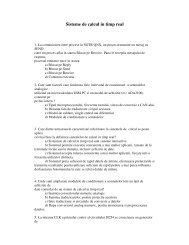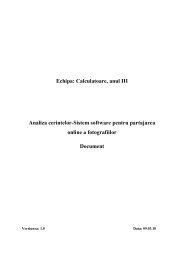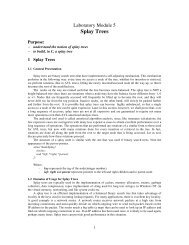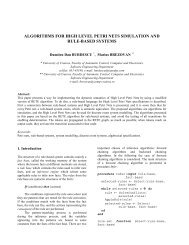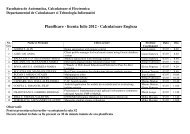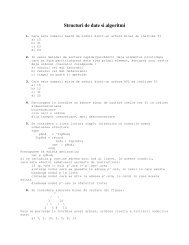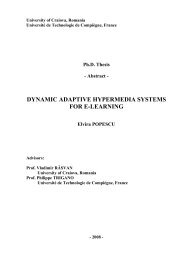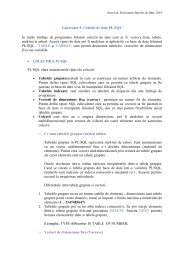You also want an ePaper? Increase the reach of your titles
YUMPU automatically turns print PDFs into web optimized ePapers that Google loves.
properties make it possible to delete and insert new values into a B-tree and adjust the tree to preserve the<br />
B-tree properties.<br />
• Leaf nodes have the same restriction on the number of elements, but have no children, and no<br />
child pointers.<br />
• The number of branches (or child nodes) from a node will be one more than the number of<br />
keys stored in the node.<br />
• A B-tree is kept balanced by requiring that all leaf nodes are at the same depth. This depth will<br />
increase slowly as elements are added to the tree, but an increase in the overall depth is infrequent, and<br />
results in all leaf nodes being one more node further away from the root.<br />
• A B-tree of depth n+1 can hold about U times as many items as a B-tree of depth n, but the cost of<br />
search, insert, and delete operations grows with the depth of the tree. As with any balanced tree, the cost<br />
grows much more slowly than the number of elements.<br />
• Considering ‘m’ the maximum number of offspring we will have the following declaration:<br />
typedef struct NodeB {<br />
int nr;<br />
int key[m+1];<br />
struct node *pchildren[m+1];<br />
}pnode;<br />
Figure 3. The structure of a node from a B tree<br />
For n greater than or equal to one, the height of an n-key b-tree T of height h with a minimum degree t<br />
greater than or equal to 2,<br />
The worst case height is O(log n). Since the "branchiness" of a b-tree can be large compared to many<br />
other balanced tree structures, the base of the logarithm tends to be large; therefore, the number of nodes<br />
visited during a search tends to be smaller than required by other tree structures. Although this does not<br />
affect the asymptotic worst case height, b-trees tend to have smaller heights than other trees with the same<br />
asymptotic height.<br />
1.2 Operations on B <strong>Trees</strong><br />
On a B-tree we can perform the following basic operations: Search, Insert, Delete.<br />
Since all nodes are assumed to be stored in secondary storage (disk) rather than primary storage<br />
(memory), all references to a given node be preceded by a read operation denoted by Disk-Read. Similarly,<br />
once a node is modified and it is no longer needed, it must be written out to secondary storage with a write<br />
operation denoted by Disk-Write.<br />
1.2.1 Searching a Key<br />
The search operation on a b-tree is analogous to a search on a binary tree. Instead of choosing between<br />
a left and a right child as in a binary tree, a b-tree search must make an n-way choice. The correct child is<br />
chosen by performing a linear search of the values in the node. After finding the value greater than or equal<br />
to the desired value, the child pointer to the immediate left of that value is followed. If all values are less<br />
than the desired value, the rightmost child pointer is followed. Of course, the search can be terminated as<br />
soon as the desired node is found. Since the running time of the search operation depends upon the height<br />
of the tree, B-Tree-Search is O(log n).<br />
3



